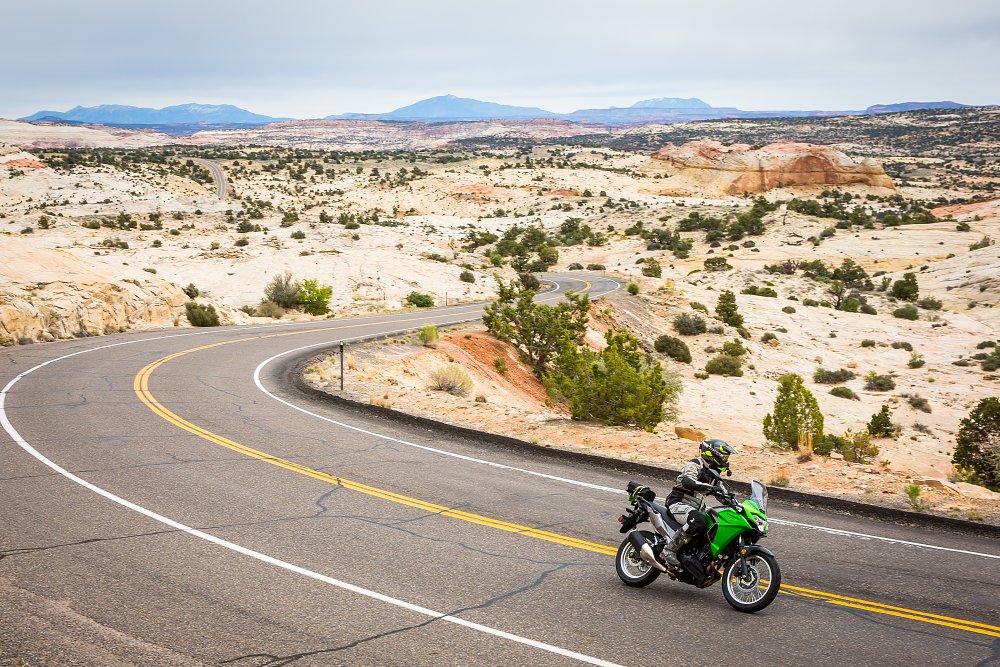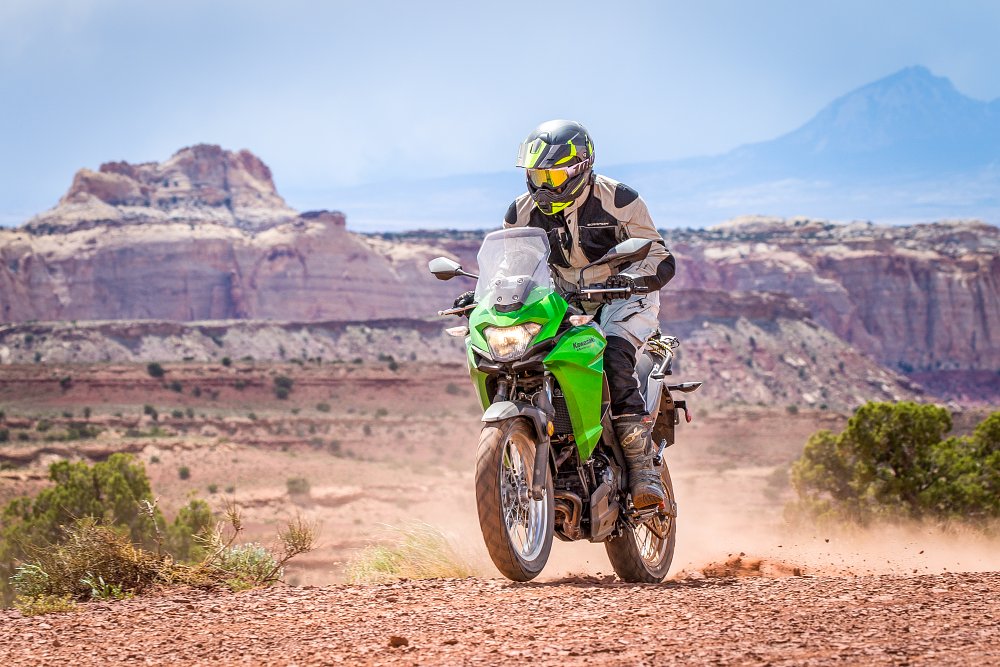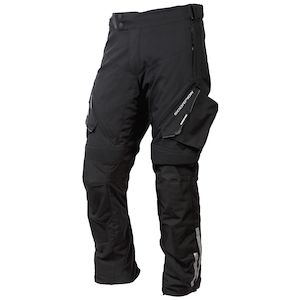What the hell is Kawasaki’s new Versys-X 300?
That seems to be the most echoed question surrounding this bike. I’ve heard from riders wanting to know if it is a dual-sport or an adventure bike. Can it replace their KLR650 or go toe-to-toe with any of the modern ADV machines already on the market? Others had questions about its off-road prowess or its long-road touring capabilities.
Over two days last week, I logged nearly 400 miles on an ABS version of the new Versys-X 300, starting in Green River, Utah, and ending in Cedar City. I rode on an interstate highway, over mountain roads, through state and federal parks and down red dirt roads mixed with sand and rock.
In this first ride review, I am going to take a look at the bike through the lens of the inquiries that I have seen rolling in from friends and fellow riders, both in person and on social media. This is the new Kawasaki Versys-X 300 as I experienced it.

The Versys-X 300
On our first night in town, Kawasaki shuttled us to a small campsite on the banks of the Green River. The swollen river pushed over its banks in a raging torrent while we were introduced to Kawasaki’s newest model in their line of small-displacement bikes.

My first question for Brad Puetz of Kawasaki was, “Why not call this the KLR300?” His response was simple: This is a street bike first with some dirt-road potential, whereas the KLR650 is an off-road bike with street potential. Because of its street-oriented roots, it belongs in the Versys family, even if it is the most dirt-oriented of its siblings.

Wheels are the most notable difference from its bigger brothers. While the Versys 650 and 1000 feature mag wheels with a sport-oriented 17-inch rim up front, the new Versys-X utilizes spoked wheels wearing a 100/90-19 tire up front and a 130/80-17 at the rear. This will allow riders to dabble in the dirt while still providing a nimble and planted experience on the street.
Kawasaki has priced the Versys-X 300 at $5,400, with ABS costing an extra $300.
The engine
For those of you who are unfamiliar with the power plant, the Versys-X utilizes the same 296 cc parallel twin that is found in the Ninja 300. It is a stressed member in the Versys-X's new frame and I found it to be relatively smooth, even when reaching the upper limits of the rpm range.

There is a lot of interest in how much low-end grunt riders can expect from this little screamer. While the internals remain the same, Kawasaki claims that changes have been made to the intake, exhaust, and final gearing to give this bike more low-end and mid-range “umph” than the Ninja 300. The reality is you’ll still have to wring this bike out if you want to squeeze the power out of it. It’s happiest when it’s singing like the world's angriest sewing machine, so don’t be afraid to run it in the upper third of the rpm range.

If you’re looking for big low-end torque, this is not your bike. Playing around off-road, I had to drop the clutch and really push it to get the rear wheel to slip at all. I found myself running second and third gears long, holding the engine speed between 9,000 and 12,000 rpm on the open dirt roads as I pitched it through the corners. The benefit here is that it is extremely difficult to unsettle this bike.
For new riders looking for a street bike that they can also use to try their hand at a little bit of dirt-road riding, it’s perfect. The torque curve never seems to spike at all. It just pulls and builds throughout the entire rev range. Riders will be able to practice tight, low-speed maneuvers all day in a variety of off-road conditions without ever feeling out of control. If a new rider accidentally gives it too much throttle input, there is minimal effect on the output, which helps to mask rider error and allows new riders to build confidence in the dirt.
Going the distance
A lot of riders have been asking about the Versys-X 300's realistic touring capabilities and highways speeds. It’s clear that Kawasaki is serious about positioning this bike as a mini mile-muncher. They planned the route to showcase what the Versys-X can handle in real-world situations.

The windshield was placed perfectly to keep the wind off my chest while letting it pass over my helmet without buffeting. Exactly what I want from my wind protection. For riders who like massive windshields, this might not be enough for you (unless you’re under six feet tall, in which case it’ll probably be plenty).
It comes standard with a basic luggage rack on the back with tie downs perfect for lashing a drybag for weekend trips. There are also factory luggage options available in the form of plastic hard bags and a color-matched top case. It’s the only 300-class street-oriented motorcycle that I am aware of that has factory luggage available for it.

I was able to check fuel mileage at two separate fill-ups and I found the bike was averaging in the high 40s mpg. That was achieved while riding the Versys-X in a “wring-its-neck” fashion, keeping the throttle pinned and pushing the 12,000 rpm redline. While I am sure I could get better numbers riding it more modestly, even with this heavy-handed approach I was averaging a range of over 200 miles per its 4.5-gallon tank.
I currently weigh in around 205 pounds (despite what Steve Kamrad has been telling people in the comments section) and I was able to run it comfortably on the highway between 70 and 75 mph. At its fastest, I pushed past 90 mph but didn’t stay there for long. As each day of riding wrapped up, I found myself with around 200 miles on the odometer and I felt just fine.

With that being said, I think my limit on this bike would be somewhere around 300 miles per day. The seat is very firm and while I liked its shape, I did find myself standing up on the highway to get some heinie relief.
Off-road expectations
I have heard a lot of riders comparing the Versys-X to the current crop of small-displacement dual-sports, mainly Honda’s CRF250L (more on that tomorrow). If you’re curious about how this bike measures up as a dual-sport, it’s important to revisit what Kawi says about this bike: It's not a dual-sport. It’s a street bike that riders can use for touring and light, off-road use. The Versys-X is much more comfortable on the street than a CRF250L while the CRF is more capable off-road.

The X’s main advantage off-road is its approachable seat height. Many riders asked if it would work for shorter riders, and at 32.1 inches, the seat height is manageable for most shorter riders while maintaining comfort for taller ones. At six-feet, three-inches tall, I was surprised with the roomy cockpit and actually preferred the stock seat to the available accessory tall seat, which adds an inch of height for lanky riders. The shortest rider on this trip stood five-feet, one-inch tall, and while she was on her tip-toes at stops, she didn’t find the bike to present her with any real problems.

The Versys’ exhaust headers, which run directly underneath the engine, are a limiting factor in its off-road performance. Kawasaki told me that the reason for this was to keep heat away from the rider and passenger, thus providing added comfort in the hotter months of the year. The problem is that with no skid plate to protect it from the abuse of larger rocks and ruts, the exhaust is first thing you’ll damage if you try to push this bike too hard in the dirt.

While the Versys-X 300 isn’t going to provide the same off-road performance as a true dual-sport machine, at 385 pounds for the ABS model, it can still run down a dirt road much more comfortably than the 500-plus-pound scramblers and larger adventure bikes we’re seeing on the market. For riders looking for a street bike that can be used to get their feet a bit dusty for the first time, the Versys-X proves to be a fun option.
A few words about suspension
The most impressive feature on this bike was the competency of the KYB suspension. The front fork provides 5.1 inches of travel while the rear shock will move 5.8 inches before bottoming out. All together, there is 7.1 inches of ground clearance before you have to worry about smashing the exhaust.

Normally, on lower-priced small-displacement motorcycles, the suspension budget is the first thing to get slashed. While there is no adjustment available, aside from a preload ring on the rear shock (exactly as I would expect on a bike like this), the spring rate and damping seem well in tune with its intended use and were not what I expected. I found the suspension to be quite compliant. It was planted on the street while absorbing the bumps and bruises off-road. I intentionally rode over any large rock or rut I could find in an effort to get the suspension to bottom out and I only succeeded once.
If you’re anything like me, you probably chuckled when you saw the marketing photos of the couple riding the Versys-X two-up. All I could think was that there is no way. Even if the engine could pull the load, surely an entry-level suspension couldn't handle it.
I just might be wrong.

While I didn’t get to try it with a passenger on the back (previously mentioned Kawi rep Brad Puetz promised to hop on the back of my bike with me but was suspiciously missing when I went looking for him), I wouldn't hesitate to give it a try. I don’t think it would necessarily be comfortable on longer trips, but I’m guessing it would fare just fine around town.
The rough edges
At the Versys-X 300's price point, there are bound to be some cost-cutting measures. The most notable one was the controls. The brake and clutch levers are not adjustable. As I have longer fingers I had no problem reaching them but I think riders with shorter fingers would benefit from some adjustability.

The ABS brakes worked well, stopping the bike confidently even on some of the wet and slippery conditions we faced on the trip. However, the ABS can’t be disabled. This is in line with most of Kawasaki’s lineup. I don’t mind having ABS, but I want to be able to turn it off for more fun off-road. As it stands, I would just save the $300 and pick up a non-ABS version, but for new riders it’s a nice safety feature to have. (Note: you can always just pull the fuse but that’s a pain in the ass and I can’t imagine a switch would be that hard for Kawi to implement.)

Kawasaki has a decently robust accessory catalog for this bike but I wish the center stand had been included in the price instead of being featured as an option. I think that any bike featuring tube-type tires should come standard with a center stand. I would recommend it to any rider planning to get this bike. It’ll pay for itself the first time you need to fix a flat.
The footpegs are weighted and feature rubber inserts to damp the vibration riders will feel in their boots. I understand why Kawasaki did this. They wanted to offer the rider the most comfortable experience possible and most riders (especially new ones) will appreciate this. Personally, I would like to see removable rubber inserts for better grip off-road. But that’s just me being nitpicky. I need to keep reminding myself that this bike is more street-oriented than not.
Conclusion
A lot of riders seem to be considering the new 300 as an alternative to other adventure bikes currently on the market.
It’s not.

This is not an alternative for large-displacement adventure bikes for experienced riders looking to replace their aging BMW F 800 GS or Triumph Tiger 800 XC. Rather, I see this as an entry-level machine for riders who want to get into adventure motorcycling. It's aimed at new riders who want a do-it-all machine to take road trips on and try their hand at a dirt road on their way to the campsite. It’s for individuals who want to get into riding but don’t identify with the current crop of 300-level motorcycles with cruiser or sport styling. I see it as a very capable city machine, as well. It sips fuel, has a long-travel suspension to soak up potholes, and can be outfitted with luggage. For the same reason, it works for commuters looking for a friendly machine to get them to the office.
It’s currently filling a hole in the market, but it won’t be alone for long. It’s going to be interesting to see how the BMW G 310 GS compares to the Versys-X 300. But for now, this is the only option for riders looking for a smaller displacement machine with adventure pretense.

I had more fun with this bike than I was expecting. Its lightweight design and nimble handling make it fun in the corners and ripping down a dirt road. The suspension and highway capabilities surprised me. Even as a rider experienced with much larger touring machines, I was able to enjoy myself on this bike and wouldn't hesitate to take it on a multiple-day adventure. With the new Versys-X 300, Kawasaki brings a new flavor of small-displacement fun to the table and this is going to benefit riders looking for an alternative to the vanilla and chocolate options we have seen for years.





















